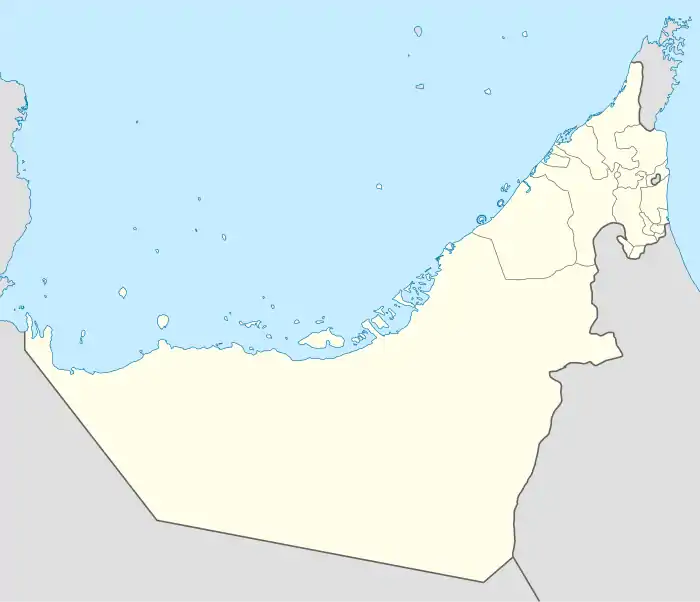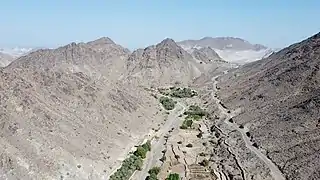Wadi Hayl
Wadi Hayl is a seasonal watercourse in the Hajar Mountains of Fujairah, in the United Arab Emirates. The wadi runs from the Fujairah industrial suburb of Al Hayl through the old (now restored) village of Hayl and Hayl Fort, to reach the Wadi Helo.
Wadi Hayl | |
|---|---|
 Wadi Hayl | |
| Coordinates: 25.103619°N 56.287247°E | |
| Country | United Arab Emirates |
| Emirate | Fujairah |
Extent
The Fujairah end of the Wadi Hayl is home to the Mohammed bin Zayed City, a planned settlement intended to comprise 1,100 houses and apartments, as well as offering services.[1] The wadi extends Westward from Fujairah and into the mountains, eventually meeting the Wadi Helo and Wadi Al Saifiyah, which itself leads to the Wadi Saham, notable for its extensive petroglyphs, and the Wadi Miduk.[2]
The Wadi Hayl is dammed above the new village of Hayl, which was built to rehouse the residents of the old village of Hayl. An Umm Al Nar tomb was found at Hayl, as well as a number of Iron Age petroglyphs[3] dotting stones throughout the course of the wadi.[4] Traditionally a Kunud village, Hayl – and the nearby Sharjah village of Al Helo – subsisted on agriculture, particularly tobacco,[2] which provided a lucrative crop for the villagers. Before the construction of the metalled road from Fujairah, the journey from Hayl to the city would take three hours by donkey.[2]
Built in 1932 by Sheikh Abdullah bin Hamdan Al Sharqi, the Fort at Hayl was constructed in 1932, along with a majlis and mosque. Often incorrectly referred to as a summer house, the Fort was in fact the principal residence for Sheikh Abdullah for over two decades.[2]
 Hayl Fort and Watchtower, looking Northwest up Wadi Hayl
Hayl Fort and Watchtower, looking Northwest up Wadi Hayl The dam in the Wadi Hayl above the new village of Hayl
The dam in the Wadi Hayl above the new village of Hayl The Wadi Hayl, facing Eastwards towards Fujairah
The Wadi Hayl, facing Eastwards towards Fujairah
References
- "Construction begins on Dh1.7bn Fujairah housing project". The National. Retrieved 18 September 2018.
- Ziolkowski, Michele & Al Sharqi, Abdullah (2006). "Bayt Sheikh Abdullah bin Hamdan Al Sharqi, Al Hayl". Tribulus. 16.2: 3–16.CS1 maint: multiple names: authors list (link)
- Ziolkowski, M. C. (May 1998). "A study of the petroglyphs from Wadi al-Hayl, Fujairah, United Arab Emirates (1)". Arabian Archaeology and Epigraphy. 9 (1): 13–89. doi:10.1111/j.1600-0471.1998.tb00109.x. ISSN 0905-7196.
- "Progress threatens rare UAE rock drawings". The National. Retrieved 19 September 2018.